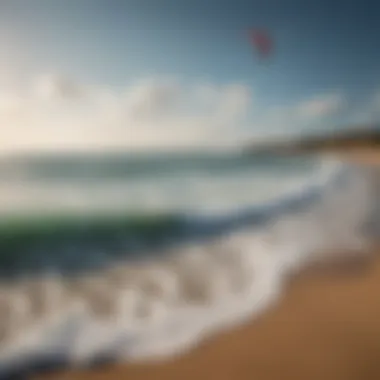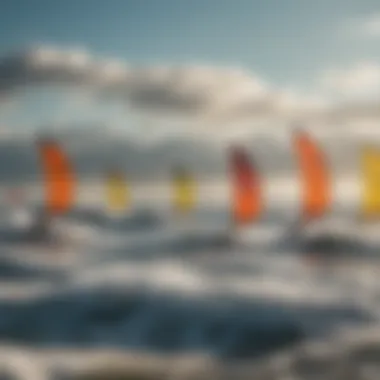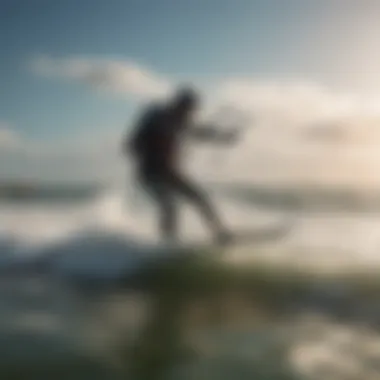Understanding Wind Maps in Georgia for Kitesurfing


Intro
Understanding wind maps is crucial for kitesurfing enthusiasts in Georgia. The state is famous for its favorable winds and beautiful coastlines. Wind maps provide insights into wind patterns, speeds, and directions. These factors are important not just for optimal riding conditions, but also for safety.
Maps indicate prevailing winds throughout different seasons, helping kitesurfers to plan excursions. Familiarizing yourself with wind maps enhances overall experience and efficiency. Some elements to consider include local topography, seasons, time of day, and regional weather conditions. This knowledge fosters confidence and performance on the water.
Equipment Reviews
Selecting appropriate equipment significantly influences kitesurfing success. State-of-the-art tools elevate your experience vastly.
Kites
Kite selection plays a pivotal role in your kiting experience. Here’s an analysis of modern kite models. Popular brands include Cabrinha, Duotone, and Naish. Each brings unique characteristics, catering to diverse rider preferences. Factors affecting kite choice include:
- Kite Shapes: Kites come in several forms, like C-kites and bow kites. Each shape offers distinct performance metrics.
- Sizes: The size of the kite dictates power and suitability for wind conditions. Larger kites generate more lift; smaller versions are better for strong winds.
- Materials: Advanced materials lead to rich durability and eye-catching designs. Opt for textiles that withstand harsh conditions and contribute to agility.
Boards
Choosing the right kite boarding board is just as vital. Depending on riding style, options vary. Look at these categories:
- Twintips: Great for versatility and jumping. These boards cater to riders looking for fun and tricks.
- Directional Boards: Best for wave styles and advanced maneuvers. They provide stability offering an edge in surf conditions. Key brands include Slingshot and Arctic.
Accessories
Ignoring accessories can lead to mishaps. Proper gear enhances safety and fun. Important accessories include:
- Harnesses: A strong harness supports body weight and control settings for riding.
- Lines: Opt for quality lines that respond well. Satisfaction in line stability contributes strongly to maneuverability.
- Safety Gear: Always prioritize personal safety. Wearing the right flotation device is non-negotiable while on the water.
Most kitesurfers understand how critical equipment performance can be. Make smart choices consistent with you skill set and conditions. Familiarity leads to favorable experiences, which multiplies every ride into unforgettable memories.
Knowledge about gear enables enthusiasts to push boards'- performance metrics. It offers kitesurfers the power to focus more on mastering skills.
Travel Destinations
Certain locations showcase ideal wind perfect for kitesurfing opportunities in and nearby Georgia.
Prelude to Wind Maps
Wind maps serve as highly valuable tools for those passionate about kitesurfing. They visualize and analyze wind patterns, which are critical in determining where and when to indulge in this thrilling sport. Knowledge of wind maps empowers kitesurfers to make informed decisions on the best location and conditions for their activity, impacting safety and enjoyment.
What are Wind Maps?
Wind maps are visual representations that depict wind patterns and speeds across different regions. They encapsulate various data, including real-time information on factors like direction and intensity. These maps can range from simple static images showing average wind speed to complex, interactive maps updated with real-time data from weather stations and satellites.
The data in wind maps come from various meteorological sources. Sensors stationed across regions capture wind conditions, and software aggregates and analyzes this information. This provides an accurate forecast of wind activity, crucial for kitesurfers aiming to plan their sessions effectively. Different types of wind maps offer insights into current conditions as well as historical trends, both of which are valuable for kitesurfing enthusiasts.
Importance of Wind Maps in Kitesurfing
Understanding wind maps is imperative for kitesurfers. Wind determines the dynamics of kitesurfing—it influences how the kite behaves in the air and affects the surfer's performance on the water. Here are a few key points on why knowledge of wind maps is essential for anyone engaging in kitesurfing:
- Safety: Having a firm grasp of wind behaviors can prevent accidents. Unstable wind patterns can lead to dangerous situations, especially for inexperienced kitesurfers. Knowledge aids in planning sessions in safer conditions.
- Enhanced Performance: Familiarity with wind maps allows kitesurfers to maximize the use of the available wind. Tracking consistent airflows can lead to improved control and more exhilarating riding experiences.
- Location Selection: Georgia boasts numerous kitesurfing spots. Each location has specific wind conditions, shaped by geographic and seasonal influences. Wind maps provide guidance on which area may offer the best conditions on any given day.
In essence, wind maps are a kitesurfer's companion, serving as both a guide and a safeguard, enabling a more enriched and secure experience in the sport.
Overview of Wind Patterns in Georgia


Kitesurfing in Georgia requires an understanding of local wind patterns. Knowing how winds behave enhances your kitesurfing experience. By studying wind patterns, kitesurfers can identify the best times to ride, thus maximizing their enjoyment. The areas in Georgia feature distinct geographic advantages and unfavorable patterns that can impact wind behavior. Understanding these elements is crucial for both recreational and competitive kitesurfers.
Geographic Influences on Winds
Georgia's landscape plays a vital role in shaping its wind characteristics. Coastal regions experience winds influenced by the Atlantic Ocean, while inland areas may see disruption in wind flow from hills and valleys. Notably, coastal geography typically offers stronger and more consistent winds, vital for successful kitesurfing sessions. Key factors at play include:
- Proximity to Water Bodies: The presence of oceanic surfaces leads to breezier conditions, particularly along coastal regions like Tybee Island.
- Elevation Changes: Local elevation variations can cause turbulence and shifts in wind direction, making certain spots less favorable. The Appalachian foothills affect patterns further inland.
- Land-Sea Breezes: Daily warming and cooling processes generate land-sea breezes, significantly influencing kitesurfing conditions during midday and afternoon hours.
Experiencing winds subtly modified by geographic features greatly affects a kitesurfer’s approach to riding the waves. Understanding how these geographical aspects shape wind conditions is worth investing time for enthusiasts in the area.
Seasonal Wind Variations
In Georgia, wind patterns are not constant; they vary by season quite significantly. Understanding these seasonal variations is vital for kitesurfers planning their sessions throughout the year. Each season presents unique opportunities and challenges, dictated by weather trends and climatic changes.
- Spring: Typically, spring brings stronger winds ideal for kitesurfing. Warmer temperatures lead to energetic wind patterns, favoring the kitesurfing season.
- Summer: While summer can offer less consistent wind, hot air resulting in sea breezes is effective during afternoons. The presence of tropical storms can boost wind activity, though precursory caution is required due to potential hazards.
- Fall: This season might feature moderate wind, consistent conditions, and fewer storms, suitable for long days on the water.
- Winter: Winds tend to be colder and can oscillate unpredictably, posing challenges for ongoing activities. Proper attire and gear become critical here for safety.
Understanding these seasonal shifts and wind behaviors helps kitesurfers in Georgia decide not only when to hit the water but also which techniques to deploy for optimizing their time in the waves. Stay informed and, like the winds, constantly adapt.
Key Factors Affecting Wind Behavior
Understanding the key factors affecting wind behavior is crucial for kitesurfers looking to harness the power of the wind in Georgia. These factors can influence not just the availability and intensity of wind, but also its direction and variability. Knowledge of these principles helps kitesurfers develop a strategic approach when planning their sessions, impacting their overall experience and safety.
Topography and Its Effects
Topography plays a significant role in shaping wind patterns across regions. Georgia features mountains, valleys, and coastal areas which can influence local wind behavior. For instance, coastal winds typically experience fewer obstructions, resulting in steadier conditions suitable for kitesurfing. On the other hand, areas with complex terrain may generate turbulent winds, leading to consistent shifts in direction and strength.
One notable example is the barrier islands along Georgia’s coast, where the effects of land and sea can create predictable wind effects at certain times of the day. The interaction of the warm sea breeze and cooler air currents coming from land creates ideal kitesurfing conditions during the afternoon, when the thermal winds peak. Kitesurfers can find it beneficial to study maps that show local topographical features to better understand the wind dynamics in those specific locations.
- Key Effects of Topography:
- Arrival of steadier coastal winds.
- Changes in wind direction due to obstacles.
- Microclimates that may affect wind strength.
Implementing this geographic understanding allows kitesurfers to optimize their outings. Paying attention to elevations and natural barriers broaden the capabilities of forecasted wind dynamics in realizing an advantageous experience on the water.
Weather Patterns and Wind Dynamics
In addition to topography, weather patterns play a pivotal role in wind behavior in Georgia. Atmospheric conditions such as high-pressure systems or frontal boundaries dramatically influence how winds flow.
Kitesurfers should monitor weather forecasts to adapt their activities and choose the best times for their sport. Seasonal effects, such as cold fronts transitioning to warmer air, typically design conditions that quickly alternate wind conditions, affecting the riding experience. Transition windows after weather systems can sometimes yield excellent wind conditions, maximized for quality floating and gliding on kiteboards.
The significance of weather patterns can be summarized concisely:
- Shifts in air pressure influence wind strength.
- Warm air versus cool air creates turbulent transitions.
- Climatic knowledge affects choices in location and timing for kitesurfing events.
To capitalize on wind best, kitesurfers are wise to couple their unique insights on local weather dynamics with strategic planning, determining rightful options in variable climates. The interplay of meteorological principles clarifies how wind may develop and represent notable opportunities for recreation.
Remember: Understanding these two key factors—topography and weather patterns—is fundamental for making informed decisions while kiteboarding in Georgia’s diverse landscapes.
Utilizing Wind Maps for Kitesurfing
Understanding how to utilize wind maps effectively is vital for enhancement of kitesurfing experiences. Wind maps provide crucial data related to wind patterns that can directly affect on-the-water performance. For kitesurfers, whether seasoned practioners or newcomers, mastering this resource leads to better decision-making and minimizes risks.
Reading and Interpreting Wind Maps
Reading wind maps is essential. A kitesurfer must be competent in understanding symbols, colors, and contour lines present in those maps. Each color typically indicates wind speed and direction, with specific shades denoting varying intensities.


- Colors: Lighter shades generally showcase light winds, whereas darker colors signify stronger winds.
- Directional Arrows: These indicate where the winds are originating from; this is crucial to determining whether conditions will be favorable for kitesurfing.
Being comfortable interpreting these elements allows kitesurfers to assess weather trends. It equips them to anticipate changes and adjust accordingly. More important, understanding forecasting techniques can decide whether to venture out or stay ashore.
Popular Kitesurfing Locations in Georgia
Kitesurfing in Georgia offers a mix of coastal and inland opportunities, making it a diversified region for enthusiasts of all levels. Understanding where to kitesurf is key to making the most out of your experience. Different locations come with unique wind patterns, varying levels of safety, and distinct environments. Knowing these elements helps rider find their ideal spots, enhancing both enjoyment and performance.
Coastal Spots: An Overview
Georgia's coastline is dotted with exceptional kitesurfing destinations that draw athletes for their impressive winds and scenic views. The region's extensive beaches serve as ideal launch pads. Popular locations like Tybee Island and St. Simons always attract kitesurfers and offer favorable wind conditions.
Tybee Island, for example, is renowned for its warm winds during the summer months. Many kitesurfers prefer riding in the vicinity of North Beach. Benefits here include ample space and minimal interference from boats.
St. Simons Island is another popular choice, particularly for its consistent trade winds from the east. The Lighthouse in the surrounding area offers an interesting backdrop and serves as a meeting point for the community.
Lakes and Inland Waterways
Inland waterways in Georgia also promise excitement for kitesurfers. Locations such as Lake Sinclair and Lake Lanier stand out for their calmer conditions, suitable for improvers and those who value less turbulent winds.
Lake Sinclair provides shallow waters, which many find perfect for learning tricks. The presence of scenic landscapes makes it an enjoyable venue for extended sessions.
Lake Lanier is comparable, with a more vibrant atmosphere. Community events often take place here, and its accessibility makes it a welcoming location for attendees at any level. Here, you can find several kitesurfing schools offering training and guidance for beginners.
Safety Considerations When Kitesurfing
Kitesurfing involves various risk factors. Therefore, understanding safe practices is important. This section highlights two key areas of focus: assessing wind conditions and understanding wind limits for beginners. These aspects ultimately ensure a safer and more enjoyable kitesurfing experience.
Assessing Wind Conditions
Wind conditions are a crucial factor in kitesurfing safety. Checking the wind direction, speed, and overall environment is necessary before entering the water. The following steps can help in this assessment:
- Check Local Wind Reports: Use reliable sources for wind forecasts. Local weather sites or specific kitesurfing forums can offer valuable information.
- Observe the Environment: Check how trees, flags, or water move with the wind. Wind shifts happen often. Watch for any changes.
- Conduct a Launch Test: Inflate your kite on land briefly to feel wind behavior. A proper test can give you a better understanding of conditions.
- Use an Anemometer: This short device helps measure wind speed on site. Being aware of exact measurements adds certainty.
Above all, constant reassessment is necessary. Wind conditions can shift unexpectedly. Have a plan for using a kite safety system in any emergency. Staying informed reduces risks significantly.
Safety is paramount. Always prioritize wind condition assessments before heading out.
Understanding Wind Limits for Beginners
New kitesurfers must be aware of physical limits imparted by wind conditions. This understanding will shape their learning journey.
- Recommended Wind Speeds: Beginners should start with wind speeds of around 10 to 18 knots. Higher speeds can lead to swifter currents and more dangerous situations.
- Choose Appropriate Equipment: Match kite sizes to wind conditions. A larger kite may have excessive pull in strong winds. Ensure comfort with the equipment choice.
- Training and Lessons: Take lessons from well-reviewed instructors. They provide valuable information about wind behaviors and safe techniques.
- Communicate: Always share your planned activities with friends or family, particularly those who can watch for you. This plan ensures someone coordinates if anything goes wrong.
Remember, awareness grows with every outing. Prioritize learning. Following wind limits prevents chaos while enjoying the sport safely.
Technological Advances in Wind Mapping
Technological advances in wind mapping play a crucial role in enhancing the kitesurfing experience in Georgia. With the integration of various digital tools and platforms, kitesurfers can access real-time information on wind patterns, significantly improving their decision-making on the water. These advances not only provide accurate data but also enable a more in-depth understanding of dynamic wind conditions.
Innovations and Apps for Kitesurfers
Current innovations have led to the development of specialized apps that cater exclusively to kitesurfers. These applications aggregate weather data from multiple sources, offering tailored information. For example, tools like Windy and Kitemovie provide up-to-date wind speed and direction, as well as wave heights and ocean temperatures. This level of detail is essential for ensuring safety and optimizing the kitesurfing experience.
These applications often include features such as:


- Interactive maps for localized assessments.
- Notifications for changes in wind conditions.
- User communities where experiences and knowledge are shared.
Through the use of these apps, kitesurfers can also access historical wind data. This information assists in identifying patterns specific to certain locations, allowing for more informed choices about when and where to kite.
The Future of Wind Mapping Technology
The future of wind mapping technology is promising, as it's expected to evolve rapidly in response to advances in atmospheric science and data analytics. Forecast models will likely incorporate artificial intelligence, enhancing prediction accuracy by processing vast amounts of data on past and present wind patterns.
Increased accessibility to high-quality satellite data will also contribute to understanding local weather phenomena. Enhanced precision in wind mapping is critical for various kitesurfing conditions, giving enthusiasts an edge.
As we move forward, developments may include:
- Integration of IoT systems for real-time wind monitoring.
- Augmented reality and advanced graphical displays for intuitive data interaction.
- Data sharing platforms that will enhance collaborative efforts among kitesurfers.
The adoption of these technologies will redefine how kitesurfers approach their sport, making informed choices easier than ever before.
Understanding wind mapping's evolution and current technological landscape helps kitesurfers better navigate their environment, ensuring that they enjoy the thrill of kitesurfing with greater confidence and insight.
Case Studies of Kitesurfing in Georgia
Examining case studies in kitesurfing offers valuable insights for both new and experienced enthusiasts. These studies highlight regional practices, preferred locations, and specific wind conditions that can enhance or detract from the kitesurfing experience in Georgia. Through practical anecdotes, kitesurfers can learn how wind patterns affect different waters. This also emphasizes the importance of community knowledge in optimizing their time on the water.
Community Experiences and Insights
Community experiences form the backbone of kitesurfing practices in Georgia. Many kitesurfers rely on personal stories and shared insights to make informed decisions. When looking into conditions like wind speed, temperature, or water currents, individual experiences can shape understanding greatly.
- Local surfers regularly gather to discuss recent sessions.
- Websites and forums often popularize specific kitesurfing locations, helping spread knowledge.
- Social media platforms, such as Facebook and Reddit, provide real-time updates about conditions and events.
- Beginner kitesurfers often seek advice from community experts, enhancing their learning curve.
The awareness created by such community interactions can drastically enhance safety and recreational enjoyment. Models of kitesurfers working together to analyze wind maps allows a richer collective intelligence that benefits all participants.
Competitive Events and Wind Influence
Competitive events in Georgia provide a excellent platform to observe the influence of wind conditions in real-time. Factors such as consistent wind patterns and direction significantly impact competition performance. Athletes at these events often face stiff winds or calm spells that sharpen their skills based on weather conditions.
Understanding these elements can influence training approaches and event strategies:
- Pre-event Assessments: Competitors study previous performance reports based on wind data to determine optimal actions.
- Real-Time Analysis: Live monitoring of wind conditions helps in making situational decisions during competitions.
- Learning Opportunities: Dynamic elements provide teachable moments for up-and-coming kitesurfers to adapt quickly.
- Athletes attending competitions often establish networks to share insights about different venues.
- Seasonal competitions attract numerous participants, further gathering data on how various wind factors play out.
The ability to combine forecasts with competitive performance solidifies participants' grasp on environmental elements. Through these techniques, competitors enhance not only their own skills, but the overall kitesurfing culture in Georgia, further cementing the connection between wind maps and kitesurfing effectiveness.
Culmination
Summarizing Key Insights
In the journey of kitesurfing, understanding wind maps in Georgia is not merely beneficial; it is essential. Wind maps provide crucial insights into prevailing wind patterns, seasonal variations, and geographic influences that shape the kitesurfing experience. By examining local weather data and historical wind trends, kitesurfers gain a clearer perspective of when and where to choose suitable locations. This knowledge helps riders to make informed decisions regarding their safety and skill development, ensuring a more enjoyable experience on the water.
The case studies discussed earlier illustrated how communities leverage wind maps. These insights highlight the variability of conditions, especially at different locations along the coast or inland.
Key insights include:
- The significance of local topography on wind behaviour.
- Seasonal shifts affecting wind intensity and direction.
- Practical applications of technology, notably innovation resources that aid kitesurfers.
- Community experiences showcasing real-world wind conditions and events.
Collectively, they reflect a deeper understanding of how to navigate Georgia's windy landscapes effectively.
The Importance of Staying Informed
Staying informed about wind maps and patterns shapes the future of kitesurfing enjoyment and performance. Consistently updated information leads to better-prepared athletes, improving risks taken while on the water. Kitesurfers achieving understanding about wind limits helps prevent unfortunate incidents or accidents.
Being proactive means tapping into various resources such as weather applications, community forums, and expert advice. For instance, platforms like Reddit enable users to share their experiences and insights. Keeping connected through channels like Facebook allows enthusiasts to discuss real-time weather conditions.
A consistent engagement means leveraging technology advancements effectively. Collaborating in this ongoing discourse and accessing up-to-date wind data can significantly elevate the quality and safety of kitesurfing experiences. In a sport dictated so heavily by nature, knowledge proves advantageous for every enthusiast seeking to ride Georgia’s winds safely and skillfully.







